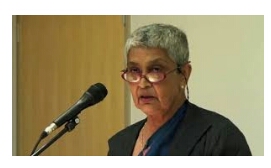Hello Readers!
This is my academic blog on thinking Activity of I. A. Richards verbal analysis. This task given by Dr. Dilip Barad head of English department.
I. A. Richards
I. A. Richard was a pioneer in the
domain of new criticism. I. A.
Richard one of the famous English critic, poet and teacher who was highly influential in developing a new way of reading poetry that led to the new criticism and that also influenced some forms of reader response criticism. Richard was born in Cheshire and educated at Cambridge university's Magdalene college.
His path breaking works:
1.The meaning of Meaning -1923
2. The principles of Literary criticism
3. The practical criticism 1929
There are three objective to wrote 1. To introduce new kind of documentation. 2. To provide new technique. 3. To prepare a new way for education method. In his work he discuss about figurative language as well as metaphorical language which was an orthodox of close textual and verbal study and analysis of work of art.
- Four kinds of meaning :
1. Sense :
Sense is what is said, or the 'items' refers to by a writer.
2. Feeling :
It refers to emotional attitudes, will,desire, pleasure, displeasure and the rest. When we say something we have a feeling about it, "an attitude towards it, some personal flavour or colouring of feeling." Words express "these feelings, these nuances of interest."
3. Tone :
Tone is the writer's attitude to his readers or audience. The use of language is determined by the writer's 'recognition' of his relation to his readers.
4. Intention :
Intention is the writer's aim, which may be conscious or unconscious. It refers to the effect that he tries to produce. This purpose modifies the expression. It controls the emphasis, shapes the arrangement, or draws attention to something of importance.
I.A . Richards views on language of poetry
- Four Types of misunderstanding :
- Misunderstanding of the sense of poetry
- Over literal reading, prosaic reading
- Defective scholarship
- Difference in meaning of words in poetry and prose.
- Verbal Analysis of poem :
Suraj Hua MaddhamSonu Nigam, Alka Yagnik,
...Suraj Hua Maddham, Chaand Jalne Laga
Aasmaan Yeh Haai Kyoon Pighalne Laga...
Suraj Hua Maddham,
Chaand Jalne Laga
Aasmaan Yeh Haai Kyoon Pighalne Laga...
Main Thehra Raha,
Zameen Chalne Lagi
Dhadka Yeh Dil,
Saans Thamne Lagi
Oh, Kya Yeh Mera Pehla Pehla Pyaar Hai
Sajna, Kya Yeh Mera Pehla Pehla Pyaar Hai
Ho Oh Oh, Oh Oh Oh Oh Oh,
Aa Aa Aa Aa Aa Aa
Suraj Hua Maddham,
Chaand Jalne Laga
Aasmaan Yeh Haai Kyoon Pighalne Laga
Main Thehri Rahi,
Zameen Chalne Lagi
Dhadka Yeh Dil,
Saans Thamne Lagi
Haan, Kya Yeh Mera Pehla Pehla Pyaar Hai
Sajna, Kya Yeh Mera Pehla Pehla Pyaar Hai
Hai Khoobsurat Yeh Pal,
Sab Kuch Raha Hai Badal
Sapne Haqeeqat Mein Jo Dhal Rahe Hai
Kya Sadiyon Se Puraana
Hai Rishtaa Yeh Hamaara
Ke Jis Tarha Tumse
Hum Mil Rahe HaiYunhi
Rahe Har Dam Pyaar Ka Mausam
Yunhi Milo Humse Tum Janam
JanamMain Thehra Raha,
Zameen Chalne Lagi
La La La, La La La, La La La
Dhadka Yeh Dil,
Saans Thamne Lagi
Haan, Kya Yeh Mera Pehla Pehla Pyaar Hai
Sajna, Kya Yeh Mera Pehla Pehla Pyaar Hai
Tere Hi Rang Se
Yun Main To Rangeen Hoon SanamPaake Tujhe Khud Se Hi Kho Rahi Hoon Sanam
O Maahiya, Ve Tere Ishq MeinHaan Doobke Paar Main Ho Rahi Hoon
SanamSaagar Hua Pyaasa,
Raat Jagne Lagi
Sholo Ke Dil Mein Bhi Aag Jalne Lagi
Main Thehri Lagi,
Zameen Chalne Lagi
Dhadka Yeh Dil,
Saans Thamne Lagi
Kya Yeh Mera Pehla Pehla Pyaar Hai
SajnaKya Yeh Mera Pehla Pehla Pyaar Hai
Suraj Hua Maddham
Chaand Jalne Laga
Aasmaan Yeh Haai
Kyoon Pighalne Laga
Sajna, Kya Yeh Mera Pehla Pehla Pyaar Hai
It is very song we can see that writer use metaphoric language. Moon, sky, land etc uses of metaphor for express lover's feeling.
How can Moon burn? How can Sky melt? How can Land walk? It is impossible but writer used metaphoric language. In this song we can find feelings of lovers to each other. Writer try to show lover's feelings through metaphors.
Lovers feel that in love, all things are not as it is but all things are changed. And they can find that all things are beautiful in love. They can also feel that their dreams are changed in reality. They have also a question in their mind that, is their relationship since before long long ago? They want to meet in all born.
Beloved tells that she follows her lover. She lost her self behind her lover.
How can sea thrust? How can night awake?
Here, writer used personification very well. And also asked many questions in this song.



